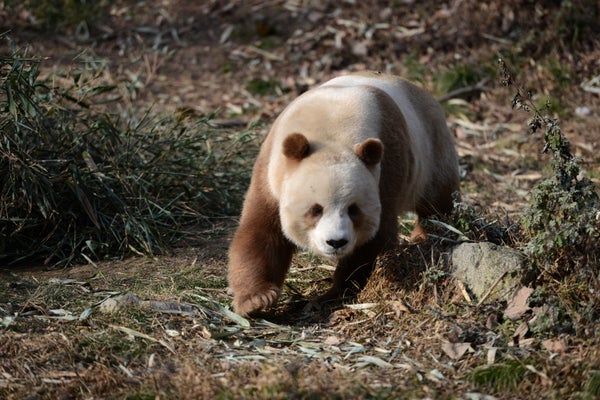Mystery of rare brown panda solved after 40 years
Chinese researchers have found the gene responsible for the brown and white fur of a handful of giant pandas
Qizai, the world’s only captive brown and white panda.
Heng Guoliang/Visual China Group via Getty Images
Everything in life is not always black and white. There are no giant pandas either.
For years, scientists in China – and the public – have been fascinated by Qizai, the only brown and white panda living in captivity. Found abandoned in the wild, he lives at the Lauguantai Wild Animal Breeding and Conservation Center in Xi’an. Only seven brown and white pandas have been documented so far – all from the Qianling mountain range in China’s Shaanxi province.
Now, a team of researchers has discovered why a 14-year-old male bear has such unusual fur, and the findings are likely to apply to wild brown pandas as well.
On supporting science journalism
If you enjoyed this article, consider supporting our award-winning journalism Subscribe By purchasing a subscription, you are helping ensure a future of impactful stories about the discoveries and ideas shaping our world today.
The brown panda is missing a short sequence of DNA. base2According to a study published today by Proceedings of the National Academy of Science,
bear in brown
Qianling pandas are “rather different” from the pandas of Sichuan – the province where most giant pandas are found (The giant panda) reside – according to Hu Yibo, co-author of the paper.
“Previous studies have shown that Qianling pandas may have diverged from Sichuan pandas about 300,000 years ago,” says Hu, a conservation geneticist at the Institute of Zoology at the Chinese Academy of Sciences (CAS) in Beijing.
Hu and his colleagues studied genomic information from three ‘family trios’ involving two brown pandas – a pair of panda parents and their cub – as well as the genomes of 29 other black and white pandas.
The trio were Qizai and his parents; Qizai, his mate and their cub; And Dandan – the first brown panda to be documented in China nearly four decades ago – his partner and their cub. Among them, only Qizai and the now dead Dandan are brown and white.
missing information
Researchers believe brown pandas are homozygous for a particular variant base2 – That is, they have identical copies of the gene. Genetic sequencing confirmed that both copies base2 The brown bear was missing a similar stretch of 25 base-pairs, the basic unit of a molecule of DNA or RNA. “This essentially means that the coding sequence for the protein gets disrupted, causing the protein to malfunction,” Hu explains.
Further genetic sequencing of 192 other black and white pandas kept in captivity showed that none were homozygous for this variant. base2, In a laboratory experiment, mice genetically modified for the mutation had lighter colored coats.
The team also found that when compared to black panda hair, brown panda hair has fewer and smaller melanosomes – the organelles responsible for hair and skin color.
“The breakthrough of this paper is the discovery that the disappearance of a gene or genetic segment can also lead to a change in color,” says Shi Peng, an evolutionary geneticist at the CAS Kunming Institute of Zoology. “From a genetics standpoint, this is a completely new discovery.”
Hu and his colleagues now plan to investigate how the 25-base-pair deletion changes the size and number of melanosomes in brown pandas.
This article is reproduced with permission and was first published on 4 March 2024,

